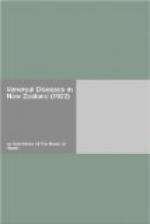The Committee would suggest that if the Pharmaceutical Society were to do all in its power to discourage its members from treating these diseases it would have a good effect.
SECTION 9.—MENTALLY DEFECTIVE ADOLESCENTS.
Mr. J. Caughley, Director of Education, stated in evidence: “From a general inquiry made by the Department a few years ago it was ascertained that there were at least six hundred or seven hundred mental defectives in New Zealand under the age of twenty-one. I need scarcely point out the moral danger to the community of so many of these defectives being at large. In particular, the girls are a source of danger to themselves and to the community, since they have little or no will-power or sense of restraint. I am of opinion that all such cases should be registered, and that, unless it can be shown that the mental defective is under thoroughly safe and proper care at home, he should be taken charge of by the State. I am certain that by this means the increasing number of mental defectives would be reduced to a minimum, since mental defectiveness is almost entirely hereditary.”
Mr. Beck, Officer in Charge of the Special Schools under the Education Department, cited illustrative cases, one of which may be thus stated: “Two feeble-minded parents in New Zealand have had up to the present time ten degenerate children, all of whom are a lifelong burden on the State. Taking the case of these children, and assessing the cost to the State of maintaining them, the total amount for this family will not be less than L16,000.”
The Committee are of opinion that supervision of mentally defective children and adolescents is an important factor in lessening venereal disease, and urge the Government as soon as possible to adopt a system of registration and classification of mental defectives, and of segregation where necessary, either in mental hospitals or in special institutions where these defectives may be suitably taught, and, where possible, usefully employed to defray the cost of their maintenance.
PART IV.—SUMMARY OF CONCLUSIONS AND RECOMMENDATIONS.
SECTION 1.—CONCLUSIONS.
Following are some of the conclusions drawn from the evidence by the Committee:—
There is very general ignorance among the public on the subject of venereal disease, and this has stood in the way of its being grappled with effectively.
Syphilis not only causes loss of life directly, but many deaths ascribed to other causes in the Registrar-General’s returns are due to the after-effects of this disease. It is responsible for many still-births and abortions, and its evil effects are seen in such children as survive. These effects may persist until the third generation.
Gonorrhoea, popularly, but quite erroneously, supposed to be a comparatively mild complaint, is regarded by medical men as being as serious a disease as syphilis. It is difficult to cure, especially in women, unless properly treated at the outset. It is a great cause of sterility in both sexes.




